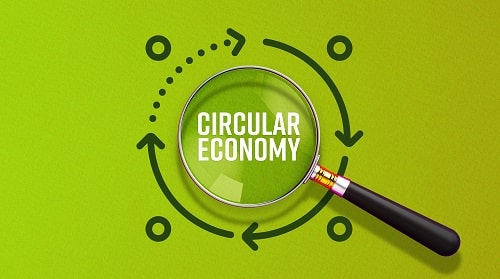Home working brings a number of sustainability benefits, such as reduced travel-related carbon footprints and costs.
Features
Home working: measuring the sustainability benefits
Businesses should be measuring and reporting on these ‘triple bottom line’ benefits as part of their efforts to improve their sustainability performance.
During the past few months, it is likely that your company has had some staff working from home. The initial move to enforced home working quite rightly centred on the health, safety and welfare aspects of staff working from home.
Recent UK government advice will mean the ‘new normal’ will probably involve a significant growth in formal home working arrangements. Consequently, your organisation should start to measure and monitor the economic, environmental and social benefits of home working as part of your business approach to sustainability.
 Home working offers for some people productivity gains due to fewer interruptions, allowing more focused work
Home working offers for some people productivity gains due to fewer interruptions, allowing more focused work
In simple terms, use the benefits that home working brings to your staff, your business and clients or customers as a positive programme.
Using the recent British Safety Council’s Live Online IEMA Foundation in Environmental Management training course as a case study, we can see the simple approach the delegates undertook to begin to measure the benefits of doing the course online (i.e. home working) and then apply it to your organisation, as the basic principles are the same.
At the end of April, I delivered a British Safety Council Live Online IEMA Foundation in Environmental Management course remotely via the Zoom video conferencing service to a group of health and safety professionals looking to upskill their environmental qualifications.
This course was originally scheduled to be delivered face-to-face at the British Safety Council’s Learning Zone training centre in Hammersmith, London.
The delegates came from all over the south-east of the UK, so it seemed only fitting that as part of a course centred around sustainability that the students calculated the business, environmental and personal benefits of doing the course remotely.
The benefits would be measured in terms of commuting time, travel and accommodation cost and associated travel-related carbon savings for the delegate, their businesses, the group as a whole and even for the British Safety Council. Of course, working from home has many other additional benefits.
Financial benefits
All the delegates who were due to commute to the course could calculate the daily travel cost savings of not having to travel from their home to the Hammersmith training centre.
All delegates would have travelled on a range of multi-modal transport options, including bus, train and/or Tube to Hammersmith. One delegate would walk given they lived closed by. Most delegates would have taken two transport options, and some would have used all three transport options to get to the Hammersmith training centre.
Some also would have been required to park at the commuting rail station after driving from their homes using fuel all week (which was estimated), and paying a daily parking fee at the rail station.
Using this simple methodology, the total cost savings across the delegates in travel costs alone was calculated, and this was a relatively straight-forward process. This came to approximately £735. Also, two students would have needed to stay at local hotels (that they had booked already) for the four nights, therefore saving £1,040 in total hotel and subsistence costs.
There were also other cost savings for the training centre in terms of reduced energy and water use and less food waste, for example. These were not calculated because the learning zone is part of the head office of the British Safety Council so individual training room energy costs would need to be calculated.
Environmental benefits
The home working delegates were then asked to calculate the mileages for the individual transport options that they would have covered during the course. They then used a carbon footprinting tool to help measure the carbon savings that they and the wider group had saved.
 Delegates together saved approximately 0.25 tonnes of carbon dioxide (CO2) from the reduction in travel
Delegates together saved approximately 0.25 tonnes of carbon dioxide (CO2) from the reduction in travel
These would be considered Scope 3 carbon savings under ISO 14064 that sets out three different Scopes (1, 2 and 3) for Greenhouse Gas Measuring and Reporting. These are:
- Scope 1 – all direct emissions from the activities of an organisation or under their control. Including fuel combustion on site such as gas boilers, fleet vehicles and air-conditioning leaks.
- Scope 2 – indirect emissions from electricity purchased and used by the organisation. Emissions are created during the production of the energy and eventually used by the organisation.
- Scope 3 – all other indirect emissions from activities of the organisation, occurring from sources that they do not own or control. These are usually the greatest share of the carbon footprint, covering emissions associated with business travel.
In total, the British Safety Council’s Live Online IEMA Foundation in Environmental Management course helped to save approximately 0.25 tonnes of carbon dioxide (CO2) from the reduction in travel.
The online course also potentially made a contribution to reducing air emissions such as nitrogen oxides (NOx), sulphur oxides (SOx) and particulate matter (PMs).
Social benefits
The social benefits from home working, especially in terms of people’s health and wellbeing, are more subjective to monitor but it is recognised that home working can improve employee retention and increase staff motivation – for example, by avoiding the need for a long daily commute and contributing to a better work/life balance.
Of the delegates on the course, all but one would have had a daily commute of between one and 1.5 hours each way. For the three students with a 1.5 hour each-way commute, this equated to 15 hours’ time saved each for the whole duration of the course.
Most other delegates saved one hour each way of commuting, resulting in a saving of approximately 10 hours’ travel time each over the week. Across the group this equated to 80 hours or 10 working days.
Therefore, all delegates saved between one and two extra working days just from not having to travel.
Home working pros and cons
Of course, there are positives and negatives to home working. However, the enforced move towards doing more of it – coupled with the fact that it will become a much wider form of working for many organisations, especially those in the service sector – means that measuring the social, economic and environmental performance of home working should be part of business performance monitoring.
The business advantages of home working include:
- Improved employee retention – home working can help retain employees with an otherwise long daily commute
- Increased staff motivation – with staff having a better work/life balance
- Convenience – ability to locate staff near clients rather than in your premises
- Financial benefits – savings on office space and other facilities
- Access to a wider pool of applicants – for example, such as those from more geographically remote areas, or people who may prefer to work from home
- Possible productivity gains – due to fewer interruptions, allowing more focused work
- Better work/life balance – employees working from home can lead to improvements in their health and wellbeing.
 Often splitting time between home and the workplace is the most productive solution
Often splitting time between home and the workplace is the most productive solution
The business disadvantages of home working include:
- Not all jobs suit home working – working from home suits some jobs better than others. Equally, working from home suits some personality types but not others. Some people may prefer colleague contact by face-to-face communication
- Decreased staff morale – it can be harder to maintain team spirit when employees are working at different locations and there could be increased feelings of isolation among home workers
- Difficulties with staff development – difficulty of maintaining staff development and upgrading skills
- Difficulty monitoring performance – there could be difficulty managing home workers and monitoring their performance
- Cost of working from home – initial costs of training and providing suitable equipment, including adaptations to meet health and safety standards
- Information security risk – information security problems and IT threats may increase.
A shift towards home working doesn’t mean employees have to work only at home. Often splitting time between home and the workplace is the most productive solution and you may want the home worker to attend meetings after the relevant Covid restrictions have been eased to keep them fully involved and informed.
Conclusion
This is a simple exercise to see how organisations can start to positively measure the impact of home working. In fact, this exercise during the British Safety Council’s Live Online course also helped to teach several aspects of the IEMA Foundation in Environmental Management syllabus, so delegates got to apply what they had learnt both to the course and ultimately to their businesses.
Businesses with the ISO 14001:2015 Environment Management System and the ISO 45001:2018 Occupational Health and Safety Management systems in place are now formally incorporating home working using the well-known ‘plan, do, check and act’ cycle.
Others are helping to quantify the economic, environmental and social benefits of home working as part of their organisation’s approach to improving sustainability performance. Some businesses have actively mapped the home working benefits to the UN 17 Sustainable Development Goals (SDGs), such as SDG 3, 8, 9, 11 and 13.
Using the Live Online IEMA Foundation in Environmental Management remote course as a case study, the home working delegates calculated that cumulatively they had saved approximately £1,775 in travel and accommodation costs, 0.25 tonnes of CO2 from reduced travel and around 16 days in accumulated travel time.
All but one of the delegates said they could work from home if the system was formalised at their business. This ranged from a day a week to full-time home working and all mentioned that the Covid-19 crisis has shown their business that working from home – albeit enforced at this time – has actually worked well for those staff who could.
It is highly likely that home working will now become much more popular for many businesses. Given the sustainability benefits that home working brings, it is only right that businesses report on these as part of their management systems or overall environmental improvements, however big or small.
Dr Keith Whitehead is Senior environmental consultant at the British Safety Council
FEATURES

How to build circular economy business models
By Chloe Miller, CC Consulting on 07 April 2025
Widespread adoption of a circular economy model by business would ensure greater environmental and economic value is extracted and retained from raw materials and products, while simultaneously reducing carbon emissions, protecting the environment and boosting business efficiency and reputation.

What does the first year on an accelerated net zero path have in store for UK businesses?
By Team Energy on 07 April 2025
The UK is halfway to net zero by 2050 and on a new, sped-up net zero pathway. In light of this, Graham Paul, sales, marketing & client services director at TEAM Energy, speaks to TEAM Energy’s efficiency and carbon reduction experts about the future of energy efficiency and net zero in the UK.

Aligning organisational culture with sustainability: a win, win for the environment and business
By Dr Keith Whitehead, British Safety Council on 04 April 2025
The culture of an organisation is crucial in determining how successfully it implements, integrates and achieves its sustainability and environmental goals and practices. However, there are a number of simple ways of ensuring a positive organisational culture where everyone is fully committed to achieving excellent sustainability performance.



